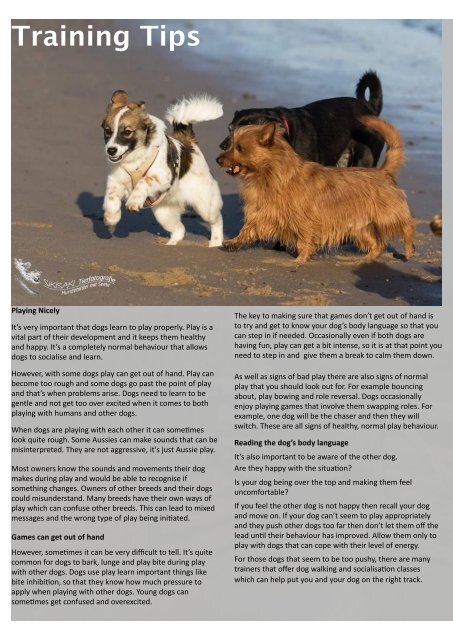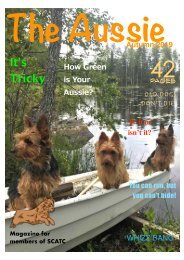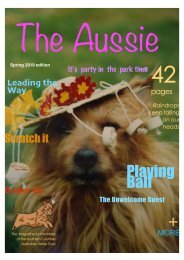THE AUSSIE - SUMMER 2019
Magazine for members of the Southern Counties Australian Terrier Club
Magazine for members of the Southern Counties Australian Terrier Club
You also want an ePaper? Increase the reach of your titles
YUMPU automatically turns print PDFs into web optimized ePapers that Google loves.
Training Tips<br />
Playing Nicely<br />
It’s very important that dogs learn to play properly. Play is a<br />
vital part of their development and it keeps them healthy<br />
and happy. It’s a completely normal behaviour that allows<br />
dogs to socialise and learn.<br />
However, with some dogs play can get out of hand. Play can<br />
become too rough and some dogs go past the point of play<br />
and that’s when problems arise. Dogs need to learn to be<br />
gentle and not get too over excited when it comes to both<br />
playing with humans and other dogs.<br />
When dogs are playing with each other it can some4mes<br />
look quite rough. Some Aussies can make sounds that can be<br />
misinterpreted. They are not aggressive, it's just Aussie play.<br />
Most owners know the sounds and movements their dog<br />
makes during play and would be able to recognise if<br />
something changes. Owners of other breeds and their dogs<br />
could misunderstand. Many breeds have their own ways of<br />
play which can confuse other breeds. This can lead to mixed<br />
messages and the wrong type of play being ini4ated.<br />
Games can get out of hand<br />
However, some4mes it can be very difficult to tell. It’s quite<br />
common for dogs to bark, lunge and play bite during play<br />
with other dogs. Dogs use play learn important things like<br />
bite inhibi4on, so that they know how much pressure to<br />
apply when playing with other dogs. Young dogs can<br />
some4mes get confused and overexcited.<br />
The key to making sure that games don’t get out of hand is<br />
to try and get to know your dog’s body language so that you<br />
can step in if needed. Occasionally even if both dogs are<br />
having fun, play can get a bit intense, so it is at that point you<br />
need to step in and give them a break to calm them down.<br />
As well as signs of bad play there are also signs of normal<br />
play that you should look out for. For example bouncing<br />
about, play bowing and role reversal. Dogs occasionally<br />
enjoy playing games that involve them swapping roles. For<br />
example, one dog will be the chaser and then they will<br />
switch. These are all signs of healthy, normal play behaviour.<br />
Reading the dog’s body language<br />
It’s also important to be aware of the other dog.<br />
Are they happy with the situa4on?<br />
Is your dog being over the top and making them feel<br />
uncomfortable?<br />
If you feel the other dog is not happy then recall your dog<br />
and move on. If your dog can’t seem to play appropriately<br />
and they push other dogs too far then don’t let them off the<br />
lead un4l their behaviour has improved. Allow them only to<br />
play with dogs that can cope with their level of energy.<br />
For those dogs that seem to be too pushy, there are many<br />
trainers that offer dog walking and socialisa4on classes<br />
which can help put you and your dog on the right track.









